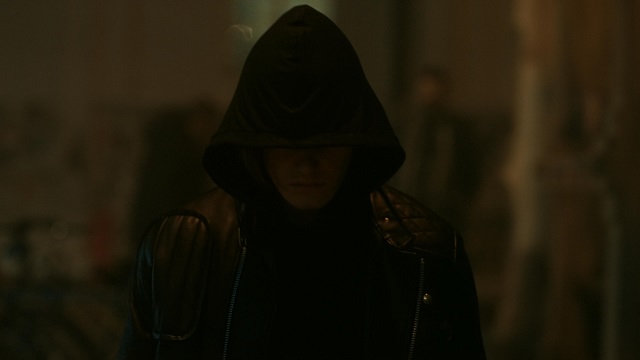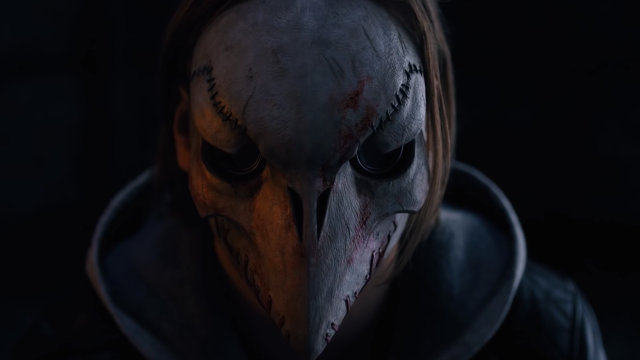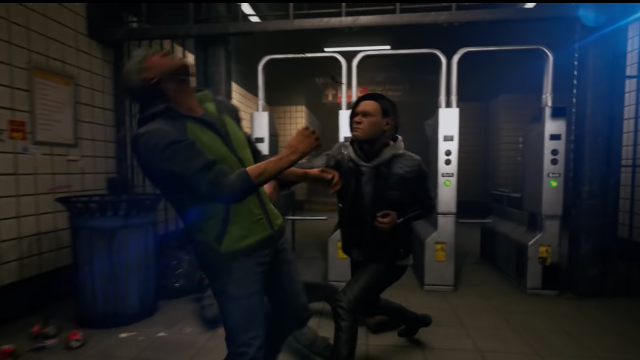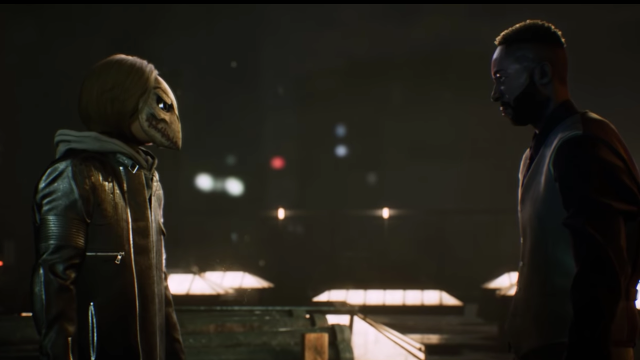In a time where vast open worlds offer increasingly boundless opportunities for exploration, VR experiences transplant players into new bodies, and elaborate role-playing games facilitate playthroughs that are custom tailored to the individual, “immersion” is a buzz-word frequently used when discussing the latest and greatest of video game art.
Each year, it seems we come ever closer to the holy grail of fully immersive gaming, and titles like The Elder Scrolls V: Skryim, The Witcher 3: Wild Hunt, and Red Dead Redemption 2 give us the chance to truly lose ourselves in the characters and universes that are so meticulously constructed for us.
However, the scale present in these games is not requisite to creating an immersive experience. A focused, small-scale approach can serve just fine when attempting to put players into someone else’s shoes.
Enter The Quiet Man, a new interactive movie co-developed by Square Enix and Human Head Studios (the developers behind Rune and Prey) with a high concept: silence.

The Quiet Man is a game without audible dialogue, and I can only assume that this emphasis on soundlessness is an attempt to allow players to inhabit the reality of the game’s deaf protagonist, Dane. Unfortunately, The Quiet Man‘s execution is so painfully muddled that any of the developers’ lofty goals have been completely obscured.
The Quiet Man is filled start-to-finish with scenes of characters talking, and while our protagonist is able to read lips and communicate using American Sign Language, the information he is privy to is never translated to the player. There are no subtitles or visual indicators making sure we are on the same page as Dane. Instead, we are left only to glean the broad strokes of the game’s narrative while watching extended sequences of muted dialogue.
If a gross understanding is all we are intended to extract from these scenes, there are endless possibilities for conveying that information without requiring players to stare confusedly at unhearable talking heads. For a game so focused on storytelling, this misstep is a major failing.
Ultimately, The Quiet Man puts us in the position of a deaf spectator trying to make sense of dialogue-centric narrative. The protagonist also happens to be deaf, but there is no immersion here, only confusion and alienation. This is not to suggest that The Quiet Man‘s narrative need to be made crystal-clear. Rather, we should enter the game through Dane’s perspective, unraveling the game’s mysteries alongside him.
There are plenty of opportunities for Dane’s deafness to impede an immediate and comprehensive understanding of the game’s plot. However, that should not be achieved by making it impossible for players to decipher what is being communicated to him on screen.
That said, while increased clarity may make The Quiet Man more comprehensible, I am not certain that the game’s narrative is salvageable even if the information Dane receives was being transmitted through an amplifier turned up to 11.
—
Note: A plot description and heavy spoilers follow.
—

The Story
The Quiet Man is an FMV game with heavy emphasis on its live-action narrative passages. However, from what I can piece together, the story of The Quiet Man is tenuous at best.
Here is my attempt to outline the game’s action:
When Dane was a child, his mother was shot by a boy that is trying to get a pair of shoes back from a bully — the perfect setup for an accidental homicide.
Dane-as-child seems to be friendly with the boy that fired the gun, and there is the indication that Dane believes that the bully was actually the one to pull the trigger (and that he was affiliated with a gang called “33”).
It is hard to imagine why he would think that, as he seems to have been a direct witness to the shooting, but it is easiest to assume that Dane is confused about who killed his mother as, years later, he is still close with the boy responsible for her death.
After the shooting, Dane is understandably devastated, and a police officer (who is either his father or a concerned citizen) takes him to a psychiatrist where young Dane draws a picture of birdman standing (atop a pile of bones) next to a woman.
Flash forward to where the action of the game begins.
Dane is a young man now, and his first task is to infiltrate the 33 gang’s hideout, recover a briefcase filled with cocaine, and promptly deliver it to the now grown executioner of his mother (Taye).
Taye hands Dane a letter that suggests a woman (very much resembling Dane’s dead mother) is being targeted by someone, and, sure enough, the woman is taken captive by a man with a bird mask that evening.
Now it is time to lay waste to everyone standing between you and that woman.
This takes you through the ranks of the 33 gang, to the bully that you believe shot your mother, to Taye (who apparently has his hands in the kidnapping as well).
My understanding of this The Crow-esque revenge spree is hazy, but, at some point, the police officer from your past assists you in reaching Taye and provides you with a bird mask that seems to give you supernatural strength and the ability to resurrect.
What happens after your confrontation with Taye I cannot say, as The Quiet Man broke irreparably, refusing to trigger a cut-scene that would advance the plot further. I am simply unwilling to replay the section leading up to the encounter in order to see the game’s conclusion, but I do not believe I would be remiss in assuming that the finale is just as nonsensical and uninspired as the story leading up to it.
I also tell you all of this because I seriously doubt you will make past the first few minutes of the game anyway.

The Gameplay
On the topic of The Quiet Man breaking, the gameplay is simply a void — a barebones and glitchy experience with the minimum amount of features required to call it a game. No tutorials, no UI, no interactive objects, no moveable camera.
The fixed camera has to be the game’s worst offense. The Quiet Man plays like a beat ’em up, but attempting to kick, punch, and dodge enemies in 3D space without being able to adjust your viewpoint is, plainly, painful.
Combined with an unresponsive combat system, some of the later encounters feel excruciatingly challenging on the harder difficulty setting. Actually timing a dodge properly in The Quiet Man felt so uncommon that I expected a statue to be erected in my honor every time I managed to land one.
Fortunately, one of the game’s few strengths is that the loading time after you are defeated is quite short, getting you back to the action quickly.
The only moments when combat feels passable are when you are fighting a single opponent, which minimizes the need to alter your focal point, or the game’s playspace flattens into a side-scroller. While the combat would still feel wooden, The Quiet Man could be a serviceable brawler just by eliminating its third dimension.
Due to these immense shortcomings, I could never find a combat strategy that felt effective. There was no sense that I was ever improving, and I relegated myself to spamming a special move that made me temporarily invulnerable, clicking buttons, and praying that I would come out the other side alive.
The problem with this approach, beyond its obvious failings as a compelling combat system, is that it was the cause of the game’s critical failure.
As I neared my encounter with Taye, The Quiet Man‘s camera was no longer able to handle my power-up move. When it was active, the camera would float in some liminal first-person space, never focusing on the action until I performed a finishing move that would end my invulnerability.
However, after fighting Taye, I put on my bird mask and went full Super Saiyan. The camera never recovered, and I was forced to quit out of the game.
All of these elements felt on the level of PlayStation 1-era shovelware, and this blankness translated to the drab and detailless environments and enemies I engaged with.
If so little effort was going to be made outside of the live-action sequences, I wonder why the developers would not just let the action occur within the live video in the way of Quick Time Events.
This would have kept The Quiet Man out of the realm of filmic dialogue, which it certainly does not want to be part of, and saved players from its inadequate gameplay experience.

The Verdict
The Quiet Man is an opportunity squandered.
A game that puts you in the place of someone with a hearing impairment could potentially be compelling in the right hands, giving players opportunities to problem solve in ways they may never have before, but these developers lost their way.
Was the original idea to make a game with a deaf protagonist, and, in a misguided attempt at immersion, all communication was extracted? Or did they want to make a soundless game and used deafness as a half-baked justification for doing so?
In either case, there is no cohesion between concept and execution in The Quiet Man, and the complete lack of attention to creating an acceptable gameplay experience pushes it over the line.
This is not a game to be enjoyed for how bafflingly incompetent it is in almost every category. It is simply bad, and you should stay away from it.
[Note: The developers provided a copy of The Quiet Man for review.]










Published: Nov 6, 2018 02:19 pm